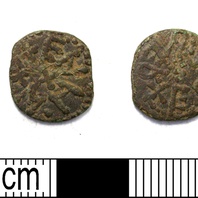
Viking Objects
Northumbrian Styca (LEIC-0D9D6F)
This Northumbrian styca was probably minted in the name of Æthelred II of Northumbria possibly by the moneyer Eanwulf. While Wessex and Mercia were using silver coinage as part of their monetary economy, Northumbria was using copper coins known as stycas, which may have contained trace amounts of silver. The concentration of these coins at sites such as Torksey and ARSNY (‘a riverine site near York’) suggests that they could have remained in circulation after the fall of Northumbria in 866 but were taken to these sites by the Vikings during their campaigning. This particular example was likely brought to Nottinghamshire from Northumbria by means of the Great Army’s overwintering activities in and around Nottingham.
Read More
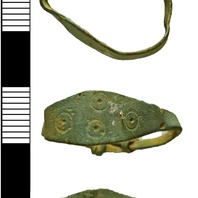
Viking Objects
Stamped Finger-Ring (NARC-031C88)
A stamped copper-alloy finger ring decorated with four double ring-and-dots in a lozengiform arrangement. Ring-and-dot was a decorative technique used at various periods from the later Iron Age onwards, but which enjoyed a Viking Age revival. Rings like this with knotted ends are typically Scandinavian.
Read More
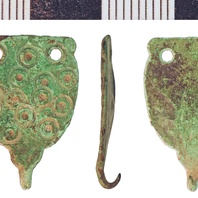
Viking Objects
Hooked Tag (NLM-8E96D5)
This example of an Anglo-Scandinavian copper-alloy hooked tag is classed as a Read Class A Type 1 or Class B Type 1. The tag is decorated with a stamped ring-and-dot motif which was a popular style among Scandinavians.
Read More
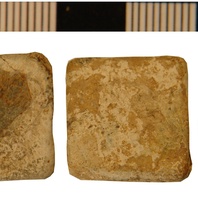
Viking Objects
Square Lead-Alloy Weight (NLM-941282)
Weights are an important form of evidence for Viking Age commerce and the use of standards across the different economic systems within which Vikings were integrated. Many of the weights discovered, particularly ones in Ireland and those of Arabic type, suggest that a standardized system of weights existed in some areas. These standard weights, alongside standard values of silver, are what allowed the bullion economy of Viking occupied areas to function. A bullion economy was a barter economy that relied on the exchange of set amounts of precious metal in various forms, such as arm-rings or coins, for tradable goods, such as food or textiles. Each merchant would have brought their own set of weights and scales to a transaction to make sure that the trade was conducted fairly.
Read More
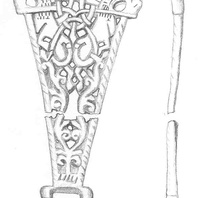
Viking Objects
Harness Fitting (NLM168)
This harness fitting, now broken into two parts, is trapezoidal in shape with two strap loops and is decorated with elaborate interlace decoration. The main element consists of two adorsed animals, possibly horses, set within a field of plant interlace.
Read More
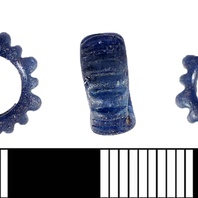
Viking Objects
Glass Bead (PUBLIC-170BD9)
This monochrome glass bead is blue coloured and has a decorative edging in a reed like pattern. Similar beads have been found in other Anglo-Scandinavian contexts. Glass beads were, generally, used in necklaces or similar jewellery and were highly prized among Scandinavians.
Read More
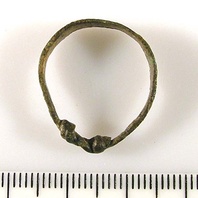
Viking Objects
Copper-Alloy Finger-Ring (LIN-E42F77)
The ring is formed by a flat band tapering to ends which have been knotted together. The outer face of the band is decorated with a row of punched ring and dot motifs.
Read More
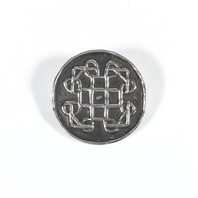
Viking Objects
Reproduction Terslev Brooch
This Borre-style brooch has been identified by Jane Kershaw as a Terslev Type V variant. Terslev style, where Scandinavian ring-chain patterns are the main decorative component, is a subcategory of the Borre style and takes its name from the silver hoard discovered in Terslev, Denmark. The decoration comprises a series of ring-knots related to the Borre ring-chain. The Terslev style occurs mainly on brooches and pendants, including both high-quality gold and silver jewellery as well as lower-end base-metal items. The cast base-metal ornaments, such as those made of copper alloy, were intended to imitate the higher-end gold and silver jewellery, and often employed techniques such as gilding to achieve this. The Terslev designs that occur in England extend the repertoire by introducing new Scandinavian motifs hitherto unrecorded in Scandinavia. For more information on Scandinavian jewellery in England check out our blog: Brooches, Pendants and Pins: Scandinavian Dress Accessories in England.
Read More
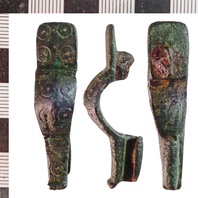
Viking Objects
Copper-Alloy Ansate Brooch (NLM-AED2E2)
The design of these brooches is a variant known as ‘caterpillar’ type which is typically geographically limited to areas bordering the North Sea, though the quantity found in England may indicate local manufacture. The original design of the brooch has a Carolingian origin. Ansate brooches are dated to between the seventh and ninth centuries though the finds at Coppergate in York may extend their popularity into the tenth century. It is possible that this particular example made its way to England prior to Viking incursions but it is equally likely that the Vikings brought this brooch with them as plunder after raiding in Frankia. For more information on Scandinavian jewellery in England check out our blog: Brooches, Pendants and Pins: Scandinavian Dress Accessories in England.
Read More
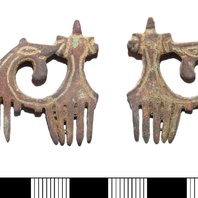
Viking Objects
Comb Pendant (LIN-DD07D2)
The pendant is decorated with two inturned zoomorphic heads executed in Ringerike-style ornament. These comb-shaped pendants are closely paralleled in the area around the Baltic Sea such as northwest Russia, Finland, Latvia and Lithuania, with rare examples from Estonia and Sweden. Pendants were a popular dress accessory in Norway and Sweden and sometimes were worn with beads between a pair of oval brooches. In England, pendants did not have the same popularity and there do not seem to be any contemporary Anglo-Saxon pendants.
Read More
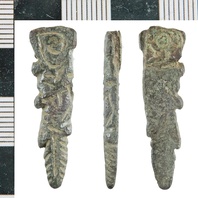
Viking Objects
Strap-End (NLM-42CC0B)
This copper-alloy strap-end is classified as a Thomas Class G type with Viking attributes. The decoration consists of large bordered eye-shaped interlace which may possibly resemble the Urnes style. Strap ends came in various styles and were fairly common throughout the Viking world. They were used to decorate the ends of belts and to stop them getting damaged.
